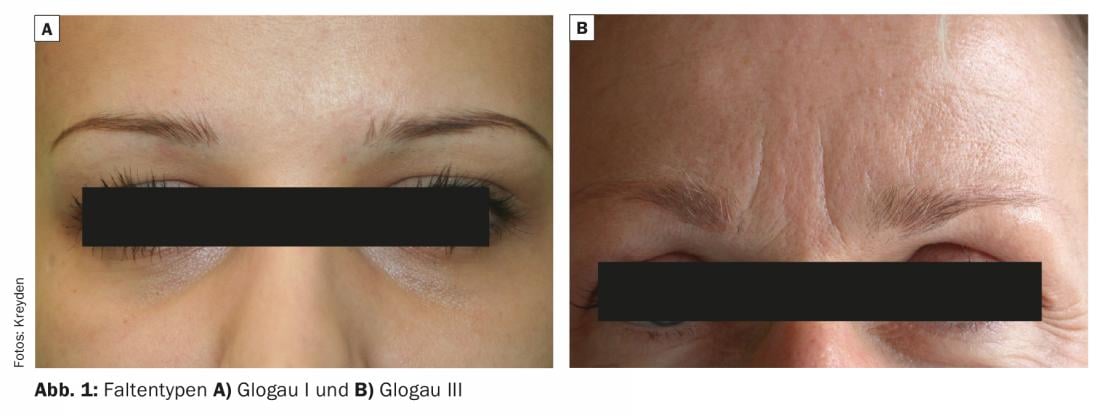Question: What is the effect of botulinum toxin (BTX) when used prophylactically?
Background: Mimic activity leads to mimic wrinkles, which can “dig” into the skin over time. In the case of strong, often unconscious mimic activity, this process is accelerated. De Maio refers to “hyperkinetic” patients [1]. They are “victims of involuntary facial expressions”, they move the muscles unconsciously, for example, frown or contract the eyebrows when they need to read or otherwise concentrate. As a result, the mimic wrinkles “dig” into the appearance of the skin more quickly and remain visible even when the mimic movement in question is not taking place at all (i.e. at rest).
Botulinum toxin A reduces mimic activity and thus the risk of wrinkles. Mimic wrinkles, i.e. wrinkles caused by muscular overactivity, can be treated well with it [2]. Adaptation to muscle activity is important [3]. The duration of action also depends on the muscle activity and the dose used.
The use of BTX in the preventive situation, i.e., in younger patients who do not yet have clinically visible “burrowed” mimic wrinkles, will be discussed below. Using the Glogau score [4], they could be described as type I patients – this compared to those with “buried” folds even at rest (Glogau III) (Fig. 1).

PATIENTS AND METHODS: Two identical 38-year-old twin sisters were studied. One of the two (“preventive” patient) had received two to three BTX treatments to the forehead and glabellar region annually over the past 13 years. In addition, a total of two BTX treatments in the area of the “crow’s feet” (lateral eyes) in the past two years. Her last injection before assessment of the forehead, glabella, and lateral eye area at rest was four months ago. The laughing-state assessment took place seven months after the last injection.
The other twin (“sporadically treated” patient) received exclusively two BTX treatments to the forehead and glabella region, one of them seven years ago, another one three years ago.
Results: BTX therapy showed no side effects in either twin.
Compared with the sporadically treated twin, the preemptively treated twin showed no visible mimic wrinkles in the forehead and glabellar region at rest.
As expected, no differences were found between the two patients in the area of the “crow’s feet” at rest – after all, treatment in the preventive twin had only been started two years ago. With a laughing face, however, the treated sister then showed significantly fewer wrinkles.
To exclude or “control” other factors of skin aging and wrinkling, the nasolabial region served as a comparison. Here, the wrinkles were at least as pronounced in the regularly treated twin as in the sporadically treated one, even at rest. According to the author, one can therefore assume comparable skin aging.
Conclusion of the author: The comparison of identical twins proves that a long-term treatment with BTX can prevent the development of “burnt-in” mimic wrinkles (so-called frown, worry and laugh lines). Patients may thus “get used to” contracting the muscles concerned only rarely or not at all, as a result of which the muscular overactivity and, consequently, the wrinkles cannot develop at all at rest.
Follow-up: An update after six additional years [5] confirmed the original results. The “preventive” patient had continued to receive (over now a total of 19 years) two to three BTX treatments to the forehead/glabella, and for now eight years also to the region of the “crows feet”. The dose has been reduced in recent years. The other twin had received a total of four treatments at that time (two, nine, and 13 years ago). Six months after the last treatment, there were still no “burnt-in” mimic wrinkles at rest in the “preventive” twin (glabella and forehead). This in contrast to the other twin. Differences were also evident in the “crow’s feet” area with deeper wrinkles in the “sporadically treated” patient. Neither twin used tobacco, both ate a comparably healthy diet and both worked in similar office conditions, the authors said. Moreover, UV radiation was stronger in the “preventive” twin (Los Angeles) than in the other (Munich).
Comment by Prof. Rzany: “Prevention takes time”.
Prevention is not just prevention. A distinction must be made between primary, secondary and tertiary prevention. Tertiary prevention is more about treatment than prevention, i.e., taking glabella folds as an example, tertiary prevention involves a deep fibrotic fold that can no longer be manually reduced. Offering botulinum toxin as the sole therapy here makes little sense. The situation is quite different in patients who do not have static wrinkles in the area of the glabella, but active wrinkles that develop only when the mimic muscles contract. Botulinum toxin A is the drug of choice here.
Botulinum toxin A is the drug of choice – although the evidence is scanty. There is only the aforementioned twin study by Binder, which, in a comparison of two sisters, shows significantly fewer wrinkles in the one sister who had regular treatment with botulinum toxin. Why is there so little data?
Prevention takes time, i.e., the usual study duration of one or even two years is not sufficient to identify clinically tangible differences. Conducting a clinical trial – the gold standard of evidence – over such a long period of time is a logical challenge and also raises ethical questions: If there is expert-based consensus that botulinum toxin A prevents the formation of glabella wrinkles, is it even permissible to conduct an appropriately randomized study over, say, five to ten years?
And here we are at consensus, i.e., expert knowledge. It is consensus among colleagues who have years of experience with the use of botulinum toxin A that static glabellar wrinkles can be prevented by timely treatment with botulinum toxin [6]. And if you want to go a step further, early treatment not only reduces glabellar wrinkles, but also enhances a positive attitude towards life. This is because botulinum toxin in the glabellar region has an antidepressant effect – as several studies have clearly shown [7].
In summary, botulinum toxin A can therefore be used for the prevention or Avoidance of static wrinkles (originally caused by mimic movements) can be used. The application is especially suitable for indications where the wrinkles – as in the area of the glabella – are associated with negative emotions. Used early, it thus leads not only to fewer static wrinkles, but probably also to a more balanced person who is more positive about life.
Comment by Dr. Zenker: “Viewing the patient holistically”.
“Wrinkle prevention” with BTX (in Glogau I type patients, i.e., without clinically visible wrinkling) is an area that is relatively difficult to study. Firstly, each patient develops wrinkles individually. In addition to external factors such as UV exposure and genetic disposition, this also has to do with individual mimic behavior. Because of this individuality and wide range, the study situation often lacks a comparison group. How is one to judge how the wrinkle pattern of the individual patient would have developed if BTX had not been used “preventively” but later? Binder escapes this dilemma by observing identical twins. Implicitly, the study assumes that the twins are so similar in their natural wrinkle development (and thus all other factors mentioned for wrinkle formation are controlled) that the comparison of a “preventive” and a largely absent BTX treatment becomes possible. In addition to individual variables on the part of the patient, however, those on the part of the treating physician (dosage, injection technique, etc.) naturally also play a role, which makes a comparison at study level even more difficult.
In the everyday clinical use of BTX, especially “preventive”, i.e. in Glogau I patients, some aspects seem important to me. First of all, the patient should always be considered holistically: For what reasons does he want the treatment? What does he hope to achieve? What is his self-image and outlook on life? What financial resources is he willing to invest in his appearance? What is certain is that BTX has a definite duration of action and is therefore a drug that requires a regular frequency of treatment (whether used “preventively” or not). This goes “into the money” and can lead to a kind of “addictive behavior” in some patients – especially those who are susceptible to it (one generates a need that is not “necessary” from a curative point of view). The factors that condition satisfaction with one’s life are so varied and complex that one should be aware that preventing wrinkles – if at all – can only contribute a part to a positive outlook on life and a positive self-image. As a physician, one has the responsibility to adequately work up the patient’s diagnostic and personal situation prior to any treatment and to consider it in the choice of therapy.
Every therapy has side effects and risks in addition to its effects. With BTX, these can be temporary events such as puncture pain, headache, bruising, etc. Of course, this must also be mentioned in the conversation with the patient.
Furthermore, there are always cases that do not react adequately (i.e. insufficiently or for a shorter time than before) to actually “reasonable” BTX doses – this is especially relevant in connection with the question of possible antibody formation. Perhaps such patients then “jump away” from you, with the remark “that it worked better with another doctor, so the effect lasted longer” (which usually turns out not to be true upon closer scrutiny). This can result in frequent changes of physicians. The summa summarum administered BTX dose is much too high and just not therapeutically adequately effective; the actual situation thus often misjudged: Because actually one would have to ask oneself – and prove this with the proof of the antibody formation in the blood – whether it concerns here perhaps BTX “resistant” cases, thus real antibody formation against Botulinumtoxin type A. Antibody formation may well occur after only a few treatments with BTX (as I have experienced several times during my work).
It must also be asked whether wrinkle prevention with BTX started at an early stage, which can mean a considerable treatment frequency and thus also a high cumulative dose over many years or even decades, is “justifiable” for the aesthetic indication from a medical-ethical point of view. Finally, in addition to wrinkle treatment, there are many other medical indications (including neurological, gynecological, hyperhidrosis, etc.). Here, a loss of effect of BTX would be far more problematic!
Of course, the above aspects do not only apply in the “preventive” situation. Especially when dealing with young patients, however, it is important to point out the long-term perspective of this treatment, the corresponding efficacy and side effect profile, the financial aspects and at least a theoretical risk of a possible insufficient response. This is the only way to ensure responsible use of the drug.
Finally, instead of “wrinkle prevention”, I would recommend talking about early “accompaniment” of the patient: With individual, professional aesthetic treatment concepts, we can accompany patients who want to “feel good in their skin” and help them to achieve a natural, thoroughly “younger” appearance, i.e. one that does not directly correspond to their age.
Source: Binder W: Long-Term Effects of Botulinum Toxin Type A (Botox) on Facial Lines. A Comparison in Identical Twins. Arch Facial Plast Surg 2006; 8(6): 426-431.
Literature:
- De Maio M, Rzany B: Patient Selection. In: De Maio M, Rzany B (eds.): Botulinum Toxin in Aesthetic Medicine. Springer 2007; 11-21.
- Kreyden OP: Advanced training course in aesthetic dermatology. Botulinum II – Practice: Upper third of the face. Dermatology Practice 2016; 26(2): 30-33.
- Kane MA, et al: Evaluation of variable-dose treatment with a new U.S. botulinum toxin type A (Dysport) for correction of moderate to severe glabellar lines: results from a phase III, randomized, double-blind, placebo-controlled study. Plast Reconstr Surg 2009 Nov; 124(5): 1619-1629.
- Glogau RG, Matarasso SL: Chemical peels. Trichloroacetic acid and phenol. Dermatol Clin 1995; 13: 263-276.
- Rivkin A, Binder W: Long-Term Effects of OnabotulinumtoxinA on Facial Lines: A 19-Year Experience of Identical Twins. Dermatol Surg 2015; 41: S64-S66.
- Landau M, et al: First Consensus on Primary Prevention and Early Intervention in Aesthetic Medicine. J Drugs Dermatol 2017 Sep 1; 16(9): 846-854.
- Chugh S, et al: Botulinum toxin as a treatment for depression in a real-world setting. J Psychiatr Pract 2018 Jan; 24(1): 15-20.
DERMATOLOGIE PRAXIS 2018; 28(2): 26-28












